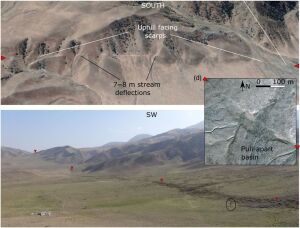
Published:
The Kopeh Dagh Fault in Turkmenistan
Graphic: Nicholas DoddsThe Main Köpetdag Fault in Turkmenistan is one of the longest (≈500 km) and fastest-slipping faults in the Arabia-Eurasian collision zone. However, unlike adjacent parts of Turkmenistan and Iran, only little instrumental and historical seismicity is known here.
Based on field observations we were able to identify a major earthquake that must have occurred in Medieval times. This is indicated by archaeological evidence and by the dating of deformed sediments. Presumably, the fault slip during this earthquake was up to 9 meters. This would correspond to a magnitude of about 7.6 - an enormous earthquake. We thus show that the lack of records of historical earthquakes in Turkmenistan could be misleading: The area has an enormously high seismic potential.
Reference:
Dodds, N., Begenjev, G., Bezmenov, Y., Gruetzner, C., Mirzin, R., Rhodes, E., Walker, R. T., & Wordsworth, P. (2022). A Major Medieval Earthquake on the Main Köpetdag (Kopeh Dagh) Fault, TurkmenistanExternal link. Bulletin of the Seismological Society of America.
